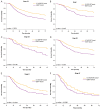Contemporary external beam radiotherapy boost or high dose-rate brachytherapy boost for cervical cancer: a propensity-score-matched, nationwide, population-based cohort study
- PMID: 33948385
- PMCID: PMC8085872
Contemporary external beam radiotherapy boost or high dose-rate brachytherapy boost for cervical cancer: a propensity-score-matched, nationwide, population-based cohort study
Abstract
To estimate the survival effects of contemporary external beam radiotherapy (EBRT) boost modalities (intensity-modulated radiation therapy or volumetric modulated arc therapy) and high dose-rate brachytherapy (HDR-BT) boost in patients with cervical cancer (CC). Patients who had been diagnosed as having CC were recruited from the Taiwan Cancer Registry Database. Propensity score matching was performed, and Cox proportional-hazards model curves were used to analyze the all-cause mortality of patients who received standard whole-pelvis irradiation with different boost modalities. The matching process yielded a final cohort of 1,630 patients (815 in the EBRT boost and HDR-BT boost groups, respectively) eligible for further analysis. The multivariate Cox regression analyses indicated that the adjusted hazard ratio (95% confidence intervals) for EBRT boost compared with HDR-BT boost was 1.62 (1.43-1.84). Multivariable analysis revealed that the independent poor prognostic factors of all-cause mortality among patients with CC were adenocarcinoma, no chemotherapy, Charlson comorbidity index score ≥ 1, age ≥ 60 years, and advanced International Federation of Gynecology and Obstetrics stage. HDR-BT boost may be more beneficial than contemporary EBRT boost in selected patients with CC.
Keywords: Cervical cancer; boost; brachytherapy; external beam radiotherapy; high dose rate.
AJCR Copyright © 2021.
Conflict of interest statement
None.
Figures
Similar articles
-
Ten-year survival after High-Dose-Rate Brachytherapy combined with External Beam Radiation Therapy in high-risk prostate cancer: A comparison with the Norwegian SPCG-7 cohort.Radiother Oncol. 2019 Mar;132:211-217. doi: 10.1016/j.radonc.2018.10.013. Epub 2018 Oct 30. Radiother Oncol. 2019. PMID: 30389241
-
Brachytherapy improves biochemical failure-free survival in low- and intermediate-risk prostate cancer compared with conventionally fractionated external beam radiation therapy: a propensity score matched analysis.Int J Radiat Oncol Biol Phys. 2015 Mar 1;91(3):505-16. doi: 10.1016/j.ijrobp.2014.11.018. Epub 2015 Jan 13. Int J Radiat Oncol Biol Phys. 2015. PMID: 25596107
-
Overall survival comparison between androgen deprivation therapy (ADT) plus external beam radiation therapy (EBRT) vs ADT plus EBRT with brachytherapy boost in clinically node-positive prostate cancer.Brachytherapy. 2020 Sep-Oct;19(5):557-566. doi: 10.1016/j.brachy.2020.05.007. Epub 2020 Jul 3. Brachytherapy. 2020. PMID: 32624405
-
Combining theoretical potential and advanced technology in high-dose rate brachytherapy boost therapy for prostate cancer.Expert Rev Med Devices. 2013 Nov;10(6):751-63. doi: 10.1586/17434440.2013.841347. Expert Rev Med Devices. 2013. PMID: 24195459 Review.
-
HDR brachytherapy for anal cancer.J Gastrointest Oncol. 2014 Jun;5(3):218-22. doi: 10.3978/j.issn.2078-6891.2014.027. J Gastrointest Oncol. 2014. PMID: 24982770 Free PMC article. Review.
Cited by
-
Cohort Profile: Chinese Cervical Cancer Clinical Study.Front Oncol. 2021 Jun 18;11:690275. doi: 10.3389/fonc.2021.690275. eCollection 2021. Front Oncol. 2021. PMID: 34222018 Free PMC article.
-
Stereotactic Ablative Brachytherapy: Recent Advances in Optimization of Radiobiological Cancer Therapy.Cancers (Basel). 2021 Jul 12;13(14):3493. doi: 10.3390/cancers13143493. Cancers (Basel). 2021. PMID: 34298703 Free PMC article. Review.
-
The Association of Preoperative PET-CT and Survival in Patients with Resectable Cervical Cancer.J Clin Med. 2022 Dec 1;11(23):7143. doi: 10.3390/jcm11237143. J Clin Med. 2022. PMID: 36498716 Free PMC article.
-
Survival effect of pre-RT PET-CT on cervical cancer: Image-guided intensity-modulated radiation therapy era.Front Oncol. 2023 Jan 31;13:1012491. doi: 10.3389/fonc.2023.1012491. eCollection 2023. Front Oncol. 2023. PMID: 36798817 Free PMC article.
-
Construction and validation of nomograms for predicting overall survival and cause-specific survival in cervical cancer patients undergoing radical radiotherapy based on the SEER database.Front Med (Lausanne). 2025 Apr 29;12:1587465. doi: 10.3389/fmed.2025.1587465. eCollection 2025. Front Med (Lausanne). 2025. PMID: 40365497 Free PMC article.
References
-
- Wong WW, Vora SA, Schild SE, Ezzell GA, Andrews PE, Ferrigni RG, Swanson SK. Radiation dose escalation for localized prostate cancer: intensity-modulated radiotherapy versus permanent transperineal brachytherapy. Cancer. 2009;115:5596–5606. - PubMed
-
- Health Promotion Administration MoHaW. Taiwan cancer registry annual report. 2017
LinkOut - more resources
Full Text Sources

